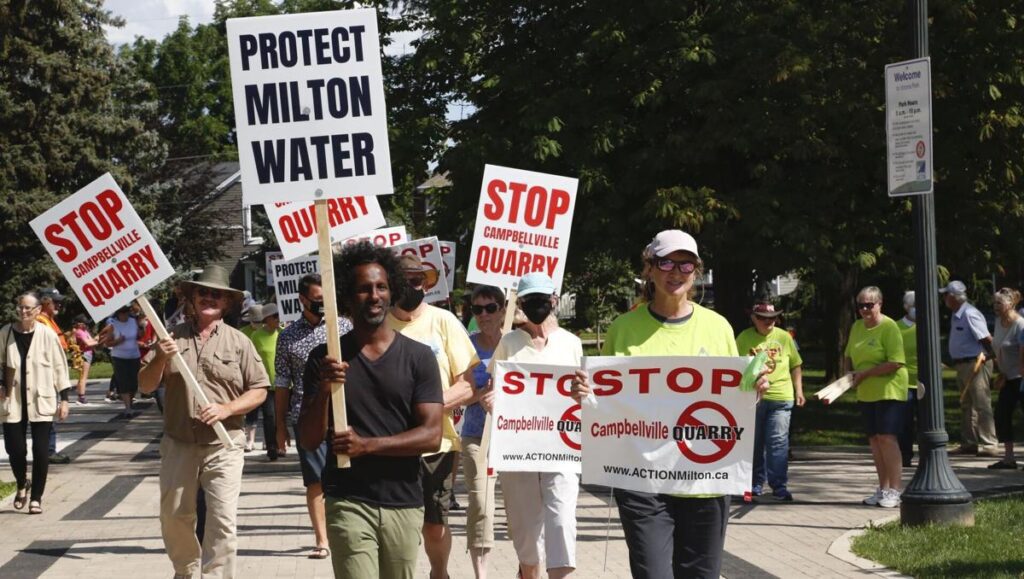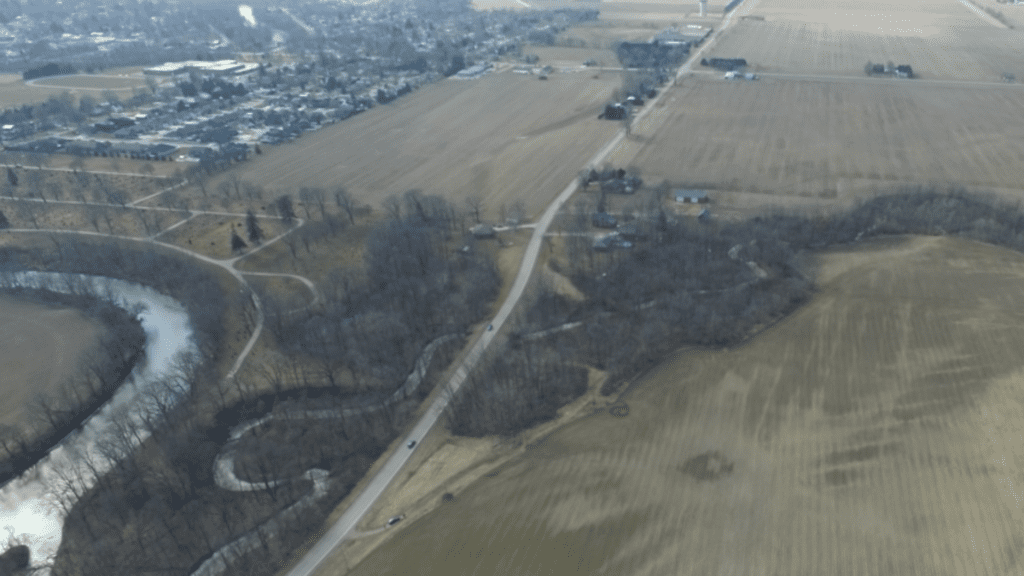As with many environmental issues, when it comes to climate change and reducing greenhouse gas emissions, this is no ordinary election.
For the past four years, Ontario has been failing on climate change. Without a plan to take strong climate action, Ontario will miss its already weak emissions reduction target, let alone the targets to reach net-zero emissions by 2050. As the province with the second highest greenhouse gas emissions in Canada, not doing enough to reduce these emissions is bad for the future of not just Ontario, but the whole country.
To help voters determine which candidates would deliver the needed course correction, Environmental Defence and its allies in the Ontario Priorities Working Group asked each of the province’s major political parties whether – and how – they would deliver the rapid emissions reductions Ontario will need to head off climate catastrophe.
Here’s what they told us.
Will your party commit to reducing the province’s greenhouse gas emissions by 60% from 2005 levels by 2030? What actions will you take to meet targets and how will you assure Ontarians that targets will be met?
Progressive Conservative (PC) Party of Ontario:
Did not answer the question.
Ontario New Democratic Party:
Our commitment is to reduce emissions from 2005 levels by at least 50% by 2030, and to achieve net-zero by 2050 or earlier.
We will institute a carbon budgeting system for the province with a reinstituted Environmental Commissioner auditing the project on a yearly basis. The plan is based on the values of equity, affordability, and reconciliation — and the principle of a just transition – where nobody, and no community, will be left behind. The plan can be found at https://www.ontariondp.ca/news/ndp-releases-ontario-s-boldest-ever-climate-plan.
Bring Ontario to net-zero emissions
- Reduce Ontario’s GHG emissions by at least 50 per cent below 2005 levels by 2030 and achieve net-zero emissions by 2050, targets consistent with the Intergovernmental Panel on Climate Change and the most ambitious aspects of the Paris Agreement
- Enshrine our GHG reduction targets, and interim targets, into law, using a carbon budgeting process to ensure 2030 and 2050 targets are met
- Restoring the powers of the Environment Commissioner of Ontario
- A new, equitable, cap-and-trade system to replace the federal carbon backstop
Change how we move: Transform transportation
- Electrify the GO Train network on an accelerated timeline
- Fund municipal transit systems to 50 per cent of their net operating costs and enable immediate service improvements, more transit routes, and increased ridership with more affordable fares
- Electrify all municipal transit fleets by 2040
- Implement Ontario’s first comprehensive zero-emissions vehicle strategy, which in part includes:
- A province-wide electric vehicle sales target of 15 per cent by 2025, 45 per cent by 2030, and 100 per cent by 2030
- Strong incentives to Ontarians who purchase electric vehicles, excluding luxury vehicles, with a particular focus on those made in Canada
- Completely electrifying government fleets by 2030
- Financial incentives for Ontario manufacturing to re-tool in order to produce zero-emissions vehicles
- Giving $600 to households to install electric vehicle charging stations at home, and requiring new homes to have vehicle charging capacity
Change how we build: Retrofit program
- A world-leading building retrofit program to improve energy efficiency, retrofitting five per cent of Ontario buildings per year
- By 2030, all newly built public, residential and commercial buildings will conform to net-zero standards
- By investing in retrofits, between 2022 and 2030 Ontario could see more than $15.2 billion added to annual GDP, which should create 100,000 good jobs
Guaranteed jobs
- Training and support for the next generation of workers, as well as workers at all stages of their career, funding and fast-tracking workers with industry experience
- New community-run recruitment centres for the skilled trades
- Job training programs specifically in colleges and training institutes in Northern Ontario
- Specific program focus on training people from marginalized communities, and those typically excluded from skilled trades, including women, racialized people, and Indigenous Peoples
- Establish Ontario’s first Youth Climate Corps
Transition the electricity supply
- Bring emissions from electricity to 2017 levels, and achieving zero emissions by 2030
- Expand hydro capacity, increase intermittent renewables including wind and solar power, create more grid scale storage, increase rooftop solar capacity on buildings, and major grid interconnection with Quebec and Manitoba to enable electricity imports
Protect water and green spaces
- Increase protection of Ontario parks and expand access to green spaces
- Develop a Provincial Food Strategy and a Provincial Water Strategy
Cut down waste
- Develop a robust and comprehensive waste diversion strategy for the public sector
Protect people’s health
- Support for accessible and culturally relevant public health campaigns to ensure all Ontarians have accurate, up-to-date information about the climate crisis and health risks associated with air and water pollution
Foster climate change resilience
- Restore funding and power to conservation authorities
- Plant one billion trees by 2030
- Expand the Greenbelt
As a part of our Green New Democratic Deal, we’ll also introduce new, environmentally progressive building standards, and support families to undertake green renovations to make their homes more energy efficient, cutting high energy bills and making monthly housing costs more affordable
Ontario Liberal Party
An Ontario Liberal government will cut greenhouse gas emissions by 50% below 2005 levels by 2030 and achieve net-zero emissions by 2050. After extensive consultations and modeling, we have a robust, costed and accounted plan to reach this deep and attainable goal. We will achieve this reduction by taking the following sets of actions:
- Require industrial and manufacturing sectors to cut their emissions further by strengthening the Emissions Performance Standards in line with our 2030 target.
- Create a robust carbon offset system to support businesses that reduce their pollution while fostering innovative carbon-cutting solutions.
- Reinvest the revenue from the carbon pricing system in a Green Jobs Fund of grants, tax credits, and loan guarantees to support cleantech and deep industrial emission reductions.
- Cut current methane levels in half and implement a methane performance standard for Ontario’s natural gas.
- Transition as quickly as possible to a fully clean energy supply while maintaining reliability and affordability, including by banning new natural gas plants, and phasing out our reliance on gas for baseload power.
- Support projects with Indigenous and Northern communities that reduce reliance on diesel and drive electrification in the remote north.
- Protect and restore Ontario’s rivers, lakes, wetlands, and watersheds.
- Build a more resilient and sustainable agricultural sector by supporting best practices that maximize carbon storage.
- Divert and recycle 60% of waste from landfills by 2030 and 85% by 2050.
- Implement a landfill ban for food and organic waste – requiring Green Bin programs to work with farmers and fuel producers to harness organic waste for renewable natural gas.
- Update the Ontario Building Code to ensure that all new buildings and renovations are built to leading energy-efficiency and climate resiliency standards by 2025.
- Provide people and small businesses with interest-free loans and grants to make high-performance energy and climate-resiliency retrofits.
- Make a record-level investment in building new public transit infrastructure, lowering the cost and improving the frequency of transit services, and maintaining existing transit infrastructure in a state of good repair.
- Introducing a rebate of up to $8,000 on the purchase or lease of a non-luxury electric vehicle and $1,500 for charging equipment.
- Rapidly expand the availability of vehicle charging stations in buildings, parking lots, city streets, and all OnRoute and GO stations.
- Mandate that at least 60% of all new passenger vehicles sold in Ontario are zero-emission by 2030 and 100% by 2035.
- Create zero-emission vehicle mandates for medium- and heavy-duty vehicles in collaboration with industry.
- Promote the use of sustainable alternative fuels in shipping, trucking, and aviation.
- Electrify all GO trains, public transit, and school buses.
- Introduce a $500 rebate for e-bikes.
- Build separated bike lanes and cycling trails, expand bike-sharing and rental services, and secure bike parking.
- Plant 800 million trees over the next 8 years.
- Invest $250 million annually to restore and expand natural infrastructure such as wetlands as well as to support communities in becoming more resilient to extreme weather.
- Mandate climate risk reporting and disclosures for public companies.
- Make the Ontario government net-zero by 2030, reducing emissions from public service infrastructure and procurement.
- Demonstrate transparency in our progress and accountability for our results through an independent Environmental Commissioner.
- Create an all-party Cabinet committee to find new ways to tackle pollution to accelerate the path to reaching emission reduction targets.
Under an Ontario Liberal government, Ontario will transition as quickly as possible to a fully clean energy supply while maintaining reliability and affordability. We will ban new natural gas plants and eventually phase out our reliance on gas for baseload power.
As part of our effort to create an efficient, flexible, and zero-carbon electricity system, we’ll eliminate set-up connection fees for rooftop solar charging panels and bidirectional vehicle charging.
Our government will develop a long-term energy plan that includes the right, cost-effective mix of nuclear, hydroelectricity, and renewable sources of energy while reversing the Ford government’s cuts to energy conservation programs.
We will implement a methane performance standard for Ontario’s natural gas to reduce emissions from home heating and advance the increased use of renewable natural gas.
Similar to the recently released unpublished scenario in the Independent Electricity System Operator’s report on phasing out natural gas in Ontario by 2030, we expect that by investing in energy storage, low-cost renewables, and energy efficiency, we will decrease costs for ratepayers while reducing our carbon pollution.
Green Party of Ontario (GPO):
As our Roadmap shows, Ontario Greens are the only party who will reduce climate pollution enough to protect a stable climate, i.e. to stay within 1.5º. Our detailed Roadmap to Net Zero is built on a science-based Fair Share Carbon Budget for the rest of the century.
The Roadmap shows how Ontario can confidently cut greenhouse gas emissions 51.2% by 2030, 70.2% by 2035, and 100% (i.e. to net zero) from 2045 to 2100. This will clean up the air, keep $billions in Ontario’s economy and create hundreds of thousands of green jobs. Even faster reductions, i.e. to 60% by 2030, may be achievable as technology improves and costs decline.
We are the only party whose climate pollution reductions will be real. Other parties rely on just planting trees (“offsets”) and hope they survive the next 100 years of fires, floods, droughts, pests and storms.
The Roadmap shows, in detail, how we will achieve this transformation to the new climate economy. It includes:
- Stopping sprawl and new highways, the largest causes of Ontario’s climate pollution.
- Increasing the price on carbon (climate pollution) by $25 per tonne per year, reaching $300 per tonne in 2032.
- Doubling Ontario’s electricity supply with clean renewables and storage.
- Turning road space into safe space for people walking, biking and rolling.
- Tripling transit use with road pricing, dedicated bus lanes and 4000 new zero-emission buses.
- Massively scaling up building retrofits and a leading edge Building Code to build new buildings right.
- Levelling the playing field by redirecting subsidies away from fossil fuels.
- Stopping fossil fuel lock-in: no new fossil fuel pipelines; no new gas-fired furnaces after 2025.
- One year’s free college tuition and guaranteed green jobs.
- Grants and a Climate Bank to help Ontario clean tech innovators become global leaders and job creators in the rapidly emerging multi-trillion dollar zero-carbon economy. By showing global leadership, we can attract international investment again, create new careers with better jobs and help build a robust economy. Public reports on annual net emissions and the remaining Fair Share Carbon Budget.
As our Roadmap shows, Ontario Greens will eliminate gas-fired electricity the fastest way compatible with minimizing Ontario’s total climate pollution. We will phase out fossil gas as quickly as possible, aiming for 2030, and double Ontario’s electricity supply with renewables by 2040.
We will prioritize investment in cost-effective renewable energy and energy efficiency efforts as part of creating an efficient, flexible and zero carbon electricity system.
That is why our Roadmap includes:
- Easy financing so people and businesses can retrofit their homes and install clean, high-efficiency electric equipment, e.g. air and ground source heat pumps and solar panels.
- Targeted subsidies to help low-income families replace baseboard heating with high efficiency heat pumps.
- Seasonal electricity storage with green hydrogen made with surplus power.
- Bi-directional EV charging to bring costs down and meet peak electricity needs.
- Work with Indigenous Peoples to site essential electricity transmission lines.
Check out our other Election Issue Guides on the Big Sprawl and on Endangered Species, Conservation Authorities, Aggregates & Water Pollution







